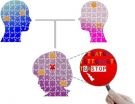(Press-News.org) NEW YORK, NY (May 21, 2014) — The overall number and nature of mutations—rather than the presence of any single mutation—influences an individual's risk of developing schizophrenia, as well as its severity, according to a discovery by Columbia University Medical Center researchers published in the latest issue of Neuron. The findings could have important implications for the early detection and treatment of schizophrenia.
Maria Karayiorgou, MD, professor of psychiatry and Joseph Gogos, MD, PhD, professor of physiology and cellular biophysics and of neuroscience, and their team sequenced the "exome"—the region of the human genome that codes for proteins—of 231 schizophrenia patients and their unaffected parents. Using this data, they demonstrated that schizophrenia arises from collective damage across several genes.
"This study helps define a specific genetic mechanism that explains some of schizophrenia's heritability and clinical manifestation," said Dr. Karayiorgou, who is acting chief of the Division of Psychiatric and Medical Genetics at the New York State Psychiatric Institute. "Accumulation of damaged genes inherited from healthy parents leads to higher risk not only to develop schizophrenia but also to develop more severe forms of the disease."
Schizophrenia is a severe psychiatric disorder in which patients experience hallucination, delusion, apathy and cognitive difficulties. The disorder is relatively common, affecting around 1 in every 100 people, and the risk of developing schizophrenia is strongly increased if a family member has the disease. Previous research has focused on the search for individual genes that might trigger schizophrenia. The availability of new high-throughput DNA sequencing technology has contributed to a more holistic approach to the disease.
The researchers compared sequencing data to look for genetic differences and identify new loss-of-function mutations—which are rarer, but have a more severe effect on ordinary gene function—in cases of schizophrenia that had not been inherited from the patients' parents. They found an excess of such mutations in a variety of genes across different chromosomes.
Using the same sequencing data, the researchers also looked at what types of mutations are commonly passed on to schizophrenia patients from their parents. It turns out that many of these are "loss-of-function" types. These mutations were also found to occur more frequently in genes with a low tolerance for genetic variation.
"These mutations are important signposts toward identifying the genes involved in schizophrenia," said Dr. Karayiorgou.
The researchers then looked more deeply into the sequencing data to try to determine the biological functions of the disrupted genes involved in schizophrenia. They were able to verify two key damaging mutations in a gene called SETD1A, suggesting that this gene contributes significantly to the disease.
SETD1A is involved in a process called chromatin modification. Chromatin is the molecular apparatus that packages DNA into a smaller volume so it can fit into the cell and physically regulates how genes are expressed. Chromatin modification is therefore a crucial cellular activity.
The finding fits with accumulating evidence that damage to chromatin regulatory genes is a common feature of various psychiatric and neurodevelopmental disorders. By combining the mutational data from this and related studies on schizophrenia, the authors found that "chromatin regulation" was the most common description for genes that had damaging mutations.
"A clinical implication of this finding is the possibility of using the number and severity of mutations involved in chromatin regulation as a way to identify children at risk of developing schizophrenia and other neurodevelopmental disorders," said Dr. Gogos. "Exploring ways to reverse alterations in chromatic modification and restore gene expression may be an effective path toward treatment."
In further sequencing studies, the researchers hope to identify and characterize more genes that might play a role in schizophrenia and to elucidate common biological functions of the genes.
INFORMATION:
The paper is titled "Loss-of-Function Variants in Schizophrenia Risk and SETD1A as a Candidate Susceptibility Gene." The other authors are Atsushi Takata (CUMC), Bin Xu (CUMC), Iuliana Ionita-Laza (CUMC), and J. Louw Roos (Pretoria University).
The authors declare no financial or other conflicts of interests.
The study was supported by grants from by National Institute of Mental Health (NIMH) grants MH061399 (to M.K.) and MH097879 (to J.A.G.) and the Lieber Center for Schizophrenia Research at Columbia University. A.T. was supported by the JSPS Postdoctoral Fellowship for Research Abroad. B.X. was partially supported by a National Alliance for Research in Schizophrenia and Depression (NARSAD) Young Investigator Award.
Columbia University Medical Center provides international leadership in basic, preclinical, and clinical research; medical and health sciences education; and patient care. The medical center trains future leaders and includes the dedicated work of many physicians, scientists, public health professionals, dentists, and nurses at the College of Physicians and Surgeons, the Mailman School of Public Health, the College of Dental Medicine, the School of Nursing, the biomedical departments of the Graduate School of Arts and Sciences, and allied research centers and institutions. Columbia University Medical Center is home to the largest medical research enterprise in New York City and State and one of the largest faculty medical practices in the Northeast. For more information, visit cumc.columbia.edu or columbiadoctors.org.
New York State Psychiatric Institute (founded in 1896) and the Columbia University Department of Psychiatry have been closely affiliated since 1925. Their co-location in a New York State facility on the NewYork-Presbyterian/Columbia University Medical Center campus provides the setting for a rich and productive collaborative relationship among scientists and physicians in a variety of disciplines. Columbia Psychiatry/NYSPI are ranked among the best departments and psychiatric research facilities in the nation and have contributed greatly to the understanding of and current treatment for psychiatric disorders. The Department and Institute are home to distinguished clinicians and researchers noted for their clinical and research advances in the diagnosis and treatment of depression, suicide, schizophrenia, bipolar and anxiety disorders and childhood psychiatric disorders. Their combined expertise provides state of the art clinical care for patients, and training for the next generation of psychiatrists and psychiatric researchers. Visit nyspi.org and columbiapsychiatry.org for more information.
CUMC on Twitter: @ColumbiaMed #CUMC
CUMC on Facebook: https://www.facebook.com/columbiamednews
Online link (with additional images): http://newsroom.cumc.columbia.edu/blog/2014/05/28/schizophrenia-genetics/
Uncovering clues to the genetic cause of schizophrenia
2014-05-28
ELSE PRESS RELEASES FROM THIS DATE:
A path toward more powerful tabletop accelerators
2014-05-28
Making a tabletop particle accelerator just got easier. A new study shows that certain requirements for the lasers used in an emerging type of small-area particle accelerator can be significantly relaxed. Researchers hope the finding could bring about a new era of accelerators that would need just a few meters to bring particles to great speeds, rather than the many kilometers required of traditional accelerators. The research, from scientists at the U.S. Department of Energy's (DOE) Lawrence Berkeley National Laboratory (Berkeley Lab), is presented as the cover story in ...
PTSD treatment cost-effective when patients given choice
2014-05-28
A cost-analysis of post-traumatic stress disorder treatments shows that letting patients choose their course of treatment – either psychotherapy or medication – is less expensive than assigning a treatment and provides a higher quality of life for patients.
In a recent study, published in the Journal of Clinical Psychiatry, PTSD patients allowed to choose between therapies ended up costing about $1,622 less on average per patient per year compared with patients who were assigned treatment. Among patients not given a choice, treatment with prolonged exposure psychotherapy ...
Technology marketers should take consumer life-cycle into account: New Rotman study
2014-05-28
Toronto – If you want grandpa to start using the bank machine instead of standing in line for the teller, the best way to do it is to tell him to "Act now!" with a limited time offer for a banking card, shows new research.
A new study from the University of Toronto's Rotman School of Management suggests marketers should pay attention to where consumers are in their lifecycles when determining how to get them to adopt new technologies.
Marketers may have incorrectly assumed that older consumers avoid products such as debit or credit cards because they are technophobic ...
Supersonic spray delivers high quality graphene layer
2014-05-28
A simple, inexpensive spray method that deposits a graphene film can heal manufacturing defects and produce a high quality graphene layer on a range of substrates, report researchers at the University of Illinois at Chicago and Korea University.
Their study is available online in the journal Advanced Functional Materials.
Graphene, a two-dimensional wonder-material composed of a single layer of carbon atoms, is strong, transparent, and an excellent conductor of electricity. It has potential in a wide range of applications, such as reinforcing and lending electrical ...
NASA sees northern Indian Ocean System 92B's end
2014-05-28
The tropical low pressure area known as System 92B finally dissipated on the east central coast of India on May 27 after six days of struggling to develop. System 92B developed in the Bay of Bengal, Northern Indian Ocean basin on May 21. NASA's TRMM, Aqua and Suomi NPP satellites captured data on the low throughout the ups and downs it experienced until wind shear finally took its toll on the system.
NASA and the Japan Aerospace Exploration Agency's Tropical Rainfall Measuring Mission (TRMM) satellite passed over System 92B on May 19 and 20 and captured data on System ...
Lethal injection comes under new scrutiny after botched execution
2014-05-28
The botched execution in April of a man convicted of murder brought to the fore of national consciousness the precarious state of capital punishment. An article in Chemical & Engineering News (C&EN), the weekly news magazine of the American Chemical Society, details the history of lethal injection, what went wrong in April and how states are currently handling the practice, once deemed the most humane way to execute prisoners.
Jyllian Kemsley, a senior editor at C&EN, explains that the three-compound procedure prison officials use to carry out executions by lethal injection ...
Brazilian researchers find human menstrual blood-derived cells 'feed' embryonic stem cells
2014-05-28
Tampa, Fla. (May 28, 2014) – To be suitable for medical transplantation, one idea is that human embryonic stem cells (hESCs) need to remain "undifferentiated" i.e. they are not changing into other cell types. In determining the best way to culture hESCs so that they remain undifferentiated and also grow, proliferate and survive, researchers have used blood cell "feeder-layer" cultures using animal-derived feeder cells, often from mice (mouse embryonic fibroblasts [MEFs]). This approach has, however, been associated with a variety of contamination problems, including pathogen ...
Can Tai Chi slow the aging process?
2014-05-28
Putnam Valley, NY. (May 28, 2014) – Tai Chi, a traditional Chinese martial art and sport, has been found to be beneficial in raising the numbers of an important type of cell when three groups of young people were tested to discover the benefits of Tai Chi, brisk walking or no exercise. The group performing Tai Chi saw a rise in their cluster of differentiation 34 expressing (CD34+) cells, a stem cell important to a number of the body's functions and structures.
The study was published in issue 23(4/5) of Cell Transplantation and is freely available on-line at: http://www.ingentaconnect.com/content/cog/ct/2014/00000023/F0020004/art00020.
"To ...
Scientists control rapid re-wiring of brain circuits using patterned visual stimulation
2014-05-28
In a new study, published in this week's issue of the journal Science, researchers show for the first time how the brain re-wires and fine-tunes its connections differently depending on the relative timing of sensory stimuli. In most neuroscience textbooks today, there is a widely held model that explains how nerve circuits might refine their connectivity based on patterned firing of brain cells, but it has not previously been directly observed in real time. This "Hebbian Theory", named after the McGill University psychologist Donald Olding Hebb who first proposed it in ...
Acute concern for health, environment highlighted at UN-backed E-waste Academy in Latin America
2014-05-28
Acute concerns about e-waste management in developing countries were highlighted in expert presentations at a recent E-waste Academy for Managers (EWAM) in El Salvador organized by UN University Institute for the Advanced Study of Sustainability (UNU-IAS) hosted Step (Solving the E-Waste Program) Initiative.
The week-long Academy ended April 4 was the second in a series inaugurated in Ghana in 2012. By sharing insights on "urban mining" and fostering international linkages and collaboration, the academies for e-waste managers, along with complementary events for e-waste-related ...





